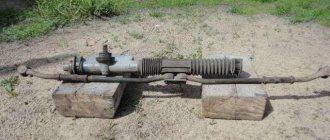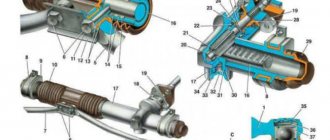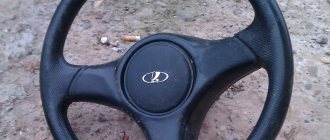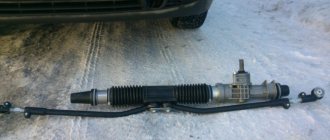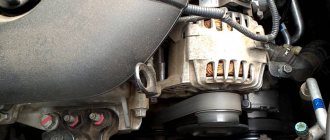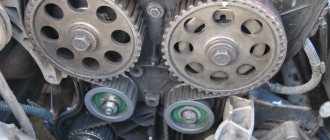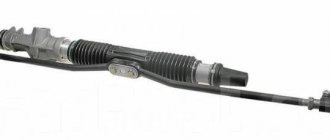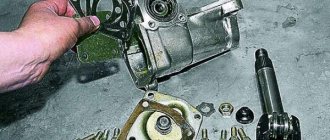Components and assemblies age, do not work correctly, and malfunctions occur in them, even to the point of failure. The so-called steering rack with power steering, which is one of the main components of the car’s steering system, is no exception. And the most common problem that arises in it is such a malfunction as a leaking steering rack. Therefore, questions related to the causes, consequences and possible repair of this device are always relevant
Operating principle of hydraulic rack control system
Comfortable driving and, most importantly, safety on the road depend on the normal operation of this unit. It must be said that the type of hydraulic steering, or more precisely with hydraulic booster, is by far the most common. The main structural elements of a hydraulic steering rack are a circuit through which the working fluid circulates, a gear shaft, a support sleeve, a special spool mechanism, a block with valves located on the steering shaft and a double-acting piston.
In general, the principle of operation is as follows. The system design includes a pump that is driven by the car engine. A rail is connected to it. When you turn the steering wheel using a torsion bar, access to the left or right cylinder opens, where oil flows under high pressure, which ensures that the car turns without any effort on the part of the driver.
Of course, the design is somewhat bulky, but even despite this fact, it is used in the vast majority of budget cars and almost all SUVs and trucks, providing reliability and ease of operation.
Additive for power steering "Suprotek GUR"
To restore performance and extend the life of the power steering
more reviews
What to do if the steering rack is leaking? We fix it urgently
Few car enthusiasts know what to do if the steering rack is leaking. Let's try to figure out why this happens and how to deal with it. After all, the safety of car operation directly depends on the condition of the steering. You should not hope for chance; as soon as you notice the slightest hint of a malfunction, immediately strive to eliminate it by any possible means. The simplest diagnostics can be carried out independently. Having determined the cause of the malfunction, it can be quickly eliminated without any problems in any garage. For this, no special tool is required. You can make do with what you have on hand.
- Technical features
- Reiki diagnostics
- Debugg
Technical features
What to do if the steering rack is leaking? To answer this question, you need to determine the technical features of this mechanism. Then it will become more clear why this happens. First, you should understand that only hydraulic racks leak. Therefore, we will look at them more carefully. Inside their cases there is a special liquid that facilitates the work of the rack, pushing it in the desired direction. The design includes a torsion bar, spool, tubes, and anthers. It is because of the latter that problems with fluid leaks from the system often occur.
Reiki diagnostics
You can determine a fluid leak by simply looking under the car after a long period of parking. If you see a puddle of dark oily liquid under the rail, then there is definitely a leak. Look under the hood, inspect all the pipes leading to the rack. If you see a leak, take steps to fix it. In most cases, the liquid supply tubes, as well as their connections, turn out to be clean. In this case, you cannot do without an overpass. Inspecting the rack from below will help determine damage. Don't delay repairs. Dirt will likely get in through the damage. This will lead to rapid failure of the rack. Replacing it entirely can be expensive.
Causes of oil leakage from the rack
Despite the reliable design of this unit, it remains operational for about 120, maximum 150 thousand km, and often much less. And then the driver observes a low oil level, characteristic oil stains on the asphalt, or even hears extraneous noise when the pump is running. All this indicates a malfunction of the hydraulic system.
Experts call the following the most common steering rack malfunctions:
- air entering the system;
- significant wear of structural parts;
- oil seal leak, which is the most common;
- pump overheating;
- use of low-quality working fluid.
It should be noted that this is not the entire list of reasons why the rack leaks. In addition to oil seals, vulnerable parts of the design of this unit are sealing rings, sliding bushings - the so-called “back plates”, bearings and support bushings, and hydraulic barrier rings. It is these structural parts that are the most vulnerable because they are constantly exposed to high loads, which are actually the first cause of wear.
There are cases of dirt entering the system through a tank or a torn protective boot. After all, dust and dirt that get into the oil turn into a kind of abrasive for structural parts, which significantly accelerates the wear of rubbing surfaces. Many drivers miss the deadline for changing the working fluid, others use low-quality fluids from unknown manufacturers.
That’s why the question arises: the rack is leaking, what should I do?! The first desire of many drivers, especially those with little driving experience, knowing about the complexity of the design and the possible consequences of a malfunction, is to replace the entire unit. Yes, indeed, this measure will give a 100% result and confidence that such a malfunction will not happen again in the near foreseeable future. However, there is a big problem - the price of the issue. A new unit is expensive. It should be understood that the main parts of its design are highly reliable and have an increased service life, so they can serve for a long time.
The conclusion suggests itself. If a leak appears, it means restoration or repair is necessary, and certainly without the need to replace the entire unit.
Let's sum it up
Many cars are equipped with power steering. It is a unit that helps reduce the effort required for the driver to rotate the steering wheel. In addition, the hydraulic booster is able to eliminate vibrations and shocks that occur while driving on uneven roads. If at one point the driver notices a leak in the steering rack, then he needs to determine the cause of the problem. Fluid leakage occurs not only due to the rack, but also due to leakage of the power steering pump and poor sealing of hoses and tubes. Having decided on the reason, the owner can change the rack himself using a repair kit, or entrust this matter to professionals. As soon as you suspect that the rack or power steering is faulty, you need to urgently resort to repairs. There is no need to delay the decision and elimination of the malfunction, because... this will make the problem worse overall.
| Tweet |
Restoration and repair procedure
There are several ways that a car owner can take in order to eliminate a power steering rack leak. The first, a complete replacement, has already been discussed. Experts question the appropriateness of this action. Although, everyone is free to spend their funds at their own discretion. You can, probably, thinking like this, and change the car itself for a new one. The next option is to drive with a leaking device and constantly replenish the working fluid to the required level. It’s a fairly common phenomenon among car enthusiasts when, for some reason, they don’t get around to making repairs. But in vain, because wasted time only further aggravates the problem.
The third option is a method that can be recommended immediately after detection of digging from under this node. We are talking about the use of special sealants.
Elimination of power steering steering rack leaks without repair work. Sealants
It is clear that over time, the most vulnerable elements of the power steering - oil seals, under the influence of high pressures, lose their properties, in particular elasticity. This leads to deformations and violations of the tightness of the system. It is impossible to replace the oil seal without removing and disassembling the unit itself. In a sense, an alternative to these complex measures that require time and money can be additives in the form of liquid agents added to working fluids.
Currently, two types of such funds are common.
The first is sealants, directly for eliminating leaks through oil seals and other seals. They contain components that penetrate rubber seals. They restore elasticity to the seals and cause a certain degree of swelling of these elements. The second type is special sealants that contain additional additives, the purpose of which is to improve the operation of the hydraulic system. Their peculiarity is the fact that, along with restoring the properties of sealing parts, they reduce friction, temperature and generally reduce the risk of malfunctions. Such products owe their additional qualities to special conditioners and other substances whose action is aimed at restoring seals and protecting rubbing parts.
Among other things, the use of sealants ensures cleaning of the channels through which the hydraulic fluid moves, the efficiency of the cleaning abilities of ATF increases, the mismatch between the servo mechanism and the steering drive is eliminated and, as a result, the service life of parts is significantly increased, the serviceability of the working fluid is extended, and the costs of repair work are reduced. After filling and the start of the sealant, leaks, as a rule, stop after 150 kilometers. A single fill is enough for 20-30 thousand kilometers. The figures indicated are not accurate and may vary depending on the specific sealant produced by a particular manufacturer.
It would seem like a eureka! A miracle cure has been found! However, everything is far from rosy. The fact is that diagnosing the power steering rack in the event of a leak without disassembling it is possible only for indirect reasons. Therefore, from the point of view of a positive result, the use of sealant is a kind of roulette, operating on the principle of “lucky or unlucky.” You will be lucky when oil seals and other rubber or plastic seals have lost their properties. In this case, the probability of eliminating the leak will be close to 100%. But you won’t be lucky in other cases if:
- the oil seal or other seal simply burst;
- high wear of the high pressure hose in the power steering system led to the appearance of a crack on it;
- the support bushing has become faulty;
- the bypass tube is cracked;
- one or another Teflon part has worn out.
We can continue to list the reasons why the power steering sealant will be powerless. However, experts advise that if a leak appears from the power steering rack, you should still first use a special sealant, proceeding according to the principle - from simple to complex.
Options for solving the problem
Before drawing any conclusions, it is necessary to get to the insides of the unit and study the degree of wear of the parts. What to do when oil leaks from the rack are detected:
- Place the car on the inspection ditch, secure it with the handbrake and remove the front wheels, placing reliable blocks.
- Using a puller, press the steering rod ball pins out of the steering knuckle eyes. First unscrew the hinge nuts.
- Remove all elements that interfere with dismantling the rail. On most passenger cars, you have to remove the battery, air filter and absorber tank.
- Turn the steering wheel all the way to lock it with a mechanical anti-theft lock. Disassemble the steering shaft to rack mount.
- Empty the power steering system and disconnect the fluid supply pipes from the unit.
- Unscrew the steering rack and remove it from the car. On some models it is attached to the body, on others - to the subframe.
Repair
The obvious option for eliminating leaks if sealants do not help is restorative repair. Currently, the car market offers special repair kits that can be used to eliminate leaks from the device.
These include seals and other small parts included in the design that are most often the cause of the problem. Such repair kits can be selected for any make of car. They are relatively inexpensive. With sets of sealing parts, they usually purchase sets of boots with clamps and special lubricant, in order to replace everything at once, without leaving behind old seals and dust protection, which can tear at any time.
Repair procedure
When the causes of oil leakage are identified, it is better to entrust their elimination to a specialist and carry out restoration work in a service station.
Repairs are carried out in the following order.
- The rack is dismantled from the car, for which it is hung on a lift, then the engine protection is removed, the heat-insulating plate is dismantled, the fasteners are unscrewed, it is removed from the mounts and pulled out. It should be noted that experts advise removing the device directly together with the steering rods. This allows for complete tightness when installing new boots.
- Disassembly:
- unscrewing from steering rods;
- unscrewing the bottom plug of the gear wheel;
- removing the retaining ring and knocking out the shaft;
- dismantling the lower oil seal;
- removing the pin that locks the upper oil seal;
- removing the retaining ring;
- pulling out the rail itself;
- removing the oil seal and bushing;
- removing the oil seal, plug, and then removing the spring and the clamping mechanism.
- Replacement of seals and, if necessary, damaged parts. If there is rust on the shaft, it is replaced with a new one. Experts do not recommend messing with grooving and grinding the shaft.
- Assembling the unit and installing it on the car is carried out in the reverse order.
Depending on the specific car model, the repair procedure may differ slightly, but the principle remains the same and in most cases, for high-quality repairs, disassembling the hydraulic unit is indispensable.
Instructions for replacing the mechanism
If the driver does not trust workshops, then he should change the rack himself. To work, you will need a certain list of tools. These include wooden supports, a screwdriver, a hammer and a liquid wrench. Additional “equipment” will be a set of socket wrenches and a puller for tips.
Before the procedure, you need to place the car on a flat surface and lock the parking brake. The steering wheel is set to “neutral”, and after that the wheel nuts are loosened one by one. All of the above actions can be classified as preparatory work.
Having completed the preparation, the owner jacks up the car and removes the wheel. Next, the vehicle is lowered onto supports. To remove the rack, you need to remove the alarm siren and adsorber. Next, the tips are dismantled, since the PPs are changed along with them. Work on different machine models differs from each other.
Detailed instructions on how to replace the rail with your own hands:
First you need to carefully remove the rail by disconnecting the bolt and bending the clamps.
Using a set with keys, the driver must disassemble the unit.
Next you need to dismantle the boot, twist the bearing and remove the shaft.
The support bushing is put in place, having previously treated the socket with a lubricant.
Next, replace the bearing and seal. In order for the oil seal to fit into place correctly, you will have to lightly tap it.
To complete the procedure, all that remains is to fold the structure, mounting the rail into the body and the shaft in its standard place. Next comes the installation of the nut and boot.
Steering sealants - a panacea or a catalyst for failure?
07/16/2018 Author: Master Service 19087
Power steering leakage is a common problem that every driver has encountered at least once. In this case, most professional mechanics advise contacting specialized service stations to check the steering and fix the leak.
But there are also those who advise the use of sealant additives, which supposedly eliminate leaks and extend the service life of all power steering components. And who to believe? Let's figure it out.
Sealant for power steering. Which is better?
Hydraulic power steering (power steering), like any other system that uses fluid pressure in its operation, is often subject to depressurization during operation. A power steering fluid leak not only forces the car owner to systematically replenish its volume, but can also lead to other unpleasant consequences. For example, even short-term operation of a hydraulic pump (for several minutes) without oil can damage it. Power steering sealants are designed to temporarily eliminate oil leaks from this system.
What if you continue to drive and add fluid?
A slight leak of power steering fluid is acceptable under circumstances when the pump works well and the steering wheel turns without visible effort. In this case, it is necessary to add oil inside the power steering reservoir on an ongoing basis.
If you continue to operate a car with a leak, the following problems may appear:
- complete loss of vehicle control;
- failure of the hydraulic pump;
- risks of an emergency, road accident while driving.
Thus, hydraulic power steering leaks cannot be ignored. As a last resort, it is better to use various sealants. If you ignore the problem, you can provoke an accident or expensive repairs.
Hi-Gear STEER PLUS power steering sealant: features
Hi-Gear STEER PLUS - this additive is very effective in eliminating oil seal leaks, which has been repeatedly proven in practice. It is suitable for protecting elements:
By adding Hi-Gear STEER PLUS sealant to the hydraulic fluid, you can significantly increase the service life of the system and avoid premature failure of the above components. It allows you to reduce power steering noise during operation and helps reduce heating.
Hi-Gear STEER PLUS can be used for preventive purposes. It ensures the elasticity of rubber elements and maintains their shape, preventing the formation of fistulas. This sealant is considered universal because it is suitable for any vehicles equipped with power steering.
The additive is not demanding on hydraulic fluids, their composition and quality. It is quickly pumped throughout the entire system and ensures complete sealing of seals and gaskets from the inside.
Power steering sealant: which one is better?
Let's briefly look at the three most common sealants for hydraulic booster on the Russian market.
The product costs, depending on the format and the seller’s markup, from 400 to 600 rubles.
All of the above products do not require any special preparation: they are simply added to the power steering expansion tank. In the case of Hi-Gear and Step Up, it may be necessary to pump out excess power steering fluid to ensure that the recommended level is not exceeded after adding the product.
There are both positive and negative reviews about all products on the Internet. And, if you carry out an analysis, it becomes clear: all compounds work if used as intended. That is, in situations where the leak is caused by minor damage to the seals or their “drying out”.
Source
Where does the leak occur?
The malfunction occurs at the junction of the steering rods with the rack, which leads to rapid fluid leakage. If there is a leak in the car, you can use a special power steering solution.
Consequences
There are some consequences that this malfunction brings:
- Vehicle damage. It looks like the controls are simply locked. This is especially noticeable at low speeds and makes driving extremely difficult.
- Loss of brake power. Some models may also lose power brakes. They will be in working order, but will need to be put under much more pressure.
- Damage to the pump. The pump will be damaged if driven with a leak because the fluid level will gradually decrease and the pump will run dry. This will cause increased friction and heat. Possible costly damage.
- Overheat.
